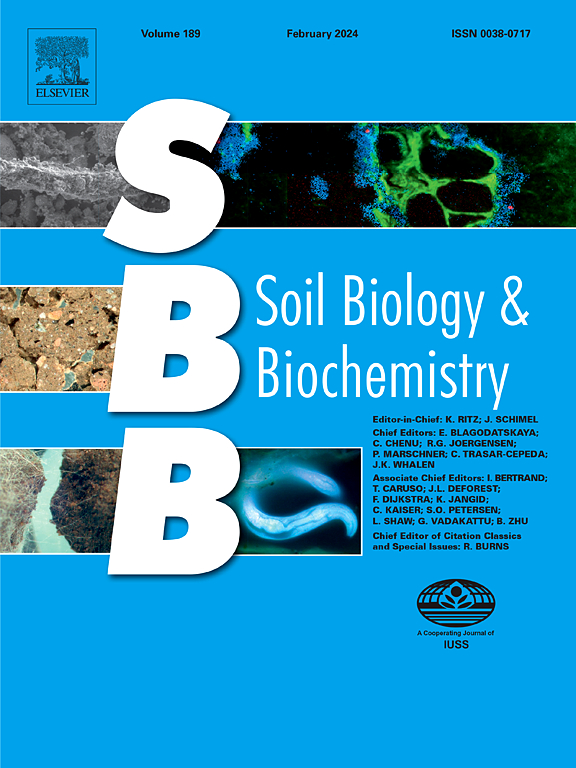AquaMEND: Reconciling multiple impacts of salinization on soil carbon biogeochemistry
IF 9.8
1区 农林科学
Q1 SOIL SCIENCE
引用次数: 0
Abstract
Soil salinization, exacerbated by climate change, poses a global threat to coastal ecosystems and soil function. Salinity affects soil carbon cycling by directly impacting microbial activity and indirectly altering soil physicochemical properties. Current models inadequately represent these complexities, relying on linear reduction functions that overlook specific physicochemical changes induced by salinity. AquaMEND addresses this gap by integrating microbial-explicit carbon decomposition modeling with advanced geochemical processes. Through the incorporation of equilibrium chemistry via PHREEQC, AquaMEND accurately predicts soil chemistry responses to salinization and enables detailed simulations on how salinity impacts microbial processes. To represent microbial responses to salinity, we developed salt-sensitive and slat-resistant response functions, with microbial activity inhibited by 50% at 4 ppt and 55 ppt, respectively. While the choice of salinity response functions influences model outcomes, simulations revealed that respiration responses to salinization varied depend on the underlying microbial mechanisms. Increased microbial mortality and impaired extracellular enzyme activity led to decreased respiration, while reduced carbon use efficiency could enhance respiration unless substrate uptake was also inhibited by high salinity. These microbial processes interact in a coordinated manner with multiple abiotic factors, collectively determining both the direction and magnitude of soil carbon responses. These findings highlight the need for novel experiments to disentangle the complex interactions governing microbial and geochemical responses to salinity. AquaMEND's capability to model such interactions offers a versatile tool for studying and predicting the effects of soil salinization on belowground carbon cycling.
AquaMEND:调和盐碱化对土壤碳生物地球化学的多重影响
气候变化加剧的土壤盐碱化对沿海生态系统和土壤功能构成全球性威胁。盐度通过直接影响微生物活性和间接改变土壤理化性质来影响土壤碳循环。目前的模型依赖于忽略了由盐度引起的特定物理化学变化的线性还原函数,不能充分反映这些复杂性。AquaMEND通过将微生物显式碳分解模型与先进的地球化学过程相结合,解决了这一差距。通过PHREEQC结合平衡化学,AquaMEND可以准确预测土壤化学对盐渍化的反应,并可以详细模拟盐度如何影响微生物过程。为了表示微生物对盐度的响应,我们开发了盐敏感和耐盐响应函数,在4 ppt和55 ppt时,微生物活性分别被抑制了50%。虽然盐度响应函数的选择会影响模型结果,但模拟显示,对盐碱化的呼吸响应取决于潜在的微生物机制。微生物死亡率增加和胞外酶活性受损导致呼吸减少,而碳利用效率降低可以增强呼吸,除非高盐度也抑制了底物的吸收。这些微生物过程与多种非生物因子协同作用,共同决定土壤碳响应的方向和幅度。这些发现强调需要新的实验来解开控制微生物和地球化学对盐度反应的复杂相互作用。AquaMEND能够模拟这种相互作用,为研究和预测土壤盐碱化对地下碳循环的影响提供了一种通用工具。
本文章由计算机程序翻译,如有差异,请以英文原文为准。
求助全文
约1分钟内获得全文
求助全文
来源期刊

Soil Biology & Biochemistry
农林科学-土壤科学
CiteScore
16.90
自引率
9.30%
发文量
312
审稿时长
49 days
期刊介绍:
Soil Biology & Biochemistry publishes original research articles of international significance focusing on biological processes in soil and their applications to soil and environmental quality. Major topics include the ecology and biochemical processes of soil organisms, their effects on the environment, and interactions with plants. The journal also welcomes state-of-the-art reviews and discussions on contemporary research in soil biology and biochemistry.
 求助内容:
求助内容: 应助结果提醒方式:
应助结果提醒方式:


